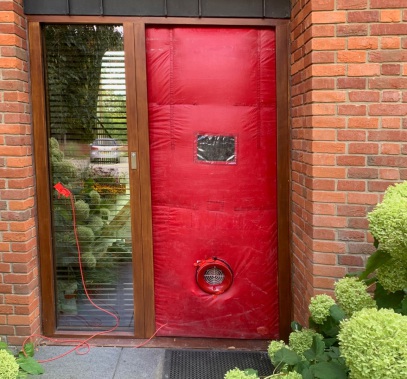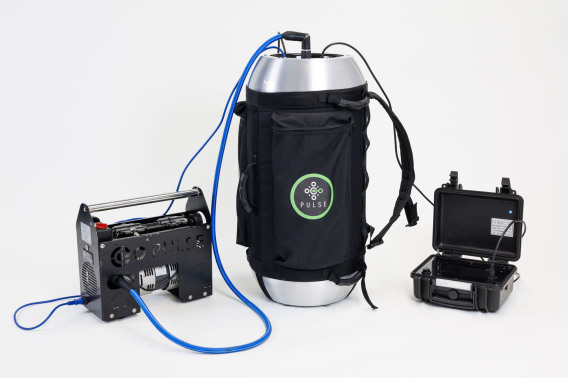
Air Pressure Testing
At the time of writing this page, the methodology used for EPC assessments of existing dwellings is RDSAP 10. A significant methodology overhaul from RDSAP to the Home Energy Model (HEM) is proposed for 2026 onwards. In addition, government consulations indicate future changes to the format of EPCs and minimum rating levels required for private rental properties. Methods for improving EPC ratings will therefore change in the future.
What is Air Pressure Testing?
Air Pressure Testing is the method of measuring how much air ecscapes unintentionally from a building through unsealed gaps, cracks & openings etc.
It excludes any air leakage through controlled ventilation systems such as extract fans.
This is relevant to EPCs and the energy performance of buildings because this air leakage affects the level of energy usage in a property.
In the winter for example, warm air exiting a building is replaced by cold fresh air from outside, and the heating system has to work harder to maintain the overall desired internal temperature.
This additional heating demand results in an increased use of 'fuel', and therefore increased financial cost and increased CO2 emissions.
One approach to making a building more energy efficient is to make it more air-tight in order to limit this effect.
In the UK, all new-build developments have required an airtightness test since the Part L update of 2013, so this type of testing has been around for quite a while now.
However, tests can also be commissioned on existing properties too, and with the introduction of RDSAP 10 on 15th June 2025, results from these tests can now be recorded in new EPC assessments of existing dwellings, although this is only optional.
The two main methods of air pressure testing are:
- Blower Door
- Pulse
Both of these methods comply with requirements of the CIBSE TM23 standard and are therefore permitted methods for demonstrating compliance for both PAS 2035, and Part L for new-build.
For an Air Pressure Test, the property is prepared by closing trickle vents and temporarily sealing extract fans and through-wall vents etc. This is important to ensure only unintentional air leakage is measured.
Results are expressed in: m3/m2/h.
A smaller value indicates the property is more airtight, and would lose less heat via escaping air, therefore resulting in less energy needed to replace that lost heat.
In contrast, a higher value indicates the property is less airtight, and would lose more heat via escaping air, therefore resulting in more energy needed to replace that lost heat.
With high levels of air tightness however, additional ventilation needs to be arranged to mitigate against poor air quality, increased moisture levels, risk of mould etc.
In terms of cost, an air pressure test is likely to be between £100 and £250.
Blower Door Method
This technology has been around since the 1980s and there are two well known manufactures of equipment: Energy Conservatory and Retrotec, both of whom are based in the United States.
The Blower Door method uses a fabric covered frame temporarily fitted in an open external doorway of the property.
A large fan in the blower door pushes air into the property, and the air pressue inside and outside are continuously monitored.
A measurement is taken of how much airflow is required through the 'blower door' to maintain a pressure difference of 50Pa between inside and outside of the property.
The high pressure of this test method is useful for testing the resilience of air tightness tapes and membranes on new builds.
Also, with the equipment running at a held pressure difference, it's possible to move around within the property and search for leakage paths. This is done by feeling for draughts, or perhaps using smoke trails from a taper to evidence the movement of air.
If you are interested in learning more about blower door testing, Retrotec have an instructional video on Youtube here:
Pulse Method
This is a newer technology which originated via the University of Nottingham and is manufactured by Build Test Solutions in the UK.
This method uses a release of compressed air from a canister, and the pressure response in the building is measured. It provides the same type of result as a blower door test but at a lower air pressure of 4Pa.
The cannister takes about 7 minutes to charge and in total the typical time required for a Pulse test might be 10 to 20 minutes compared to 20 to 50 minutes for a blower door test.
This is quite a simple, non-invasive push-button means of measuring whole fabric air leakage.
Build Test Solutions are the UK based manufacturer of Pulse equipment. Their website is at:
https://www.buildtestsolutions.com/air-leakage-and-ventilation/pulse-air-permeability-testing
They have an information video about Pulse testing on Youtube here:
Air Pressure Testing versus Background Ventilation Testing
There is another slightly different form of testing known as Background Ventilation Testing.
This type of tesing was introduced to the industry through Retrofit which is the field of applying energy improvement measures to existing buildings.
A need was identified to prove that dwellings being subject to retrofit improvement under PAS 2035 had such adequate existing ventilation that they would not require provision of additional ventilation.
Background Ventilation is measured in terms of an Air Change Rate which is expressed as ACH, or air changes per hour.
This is the number of times the entire volume of space in a building is replaced per hour.
1 ACH means that all the air inside the building is exchanged once with air from outside the building, per hour.
3 ACH means that all the air inside the building is exchanged three times with air from outside the building, per hour.
Testing complies with Installation Assurance Authority (IAA) guidance.
The property is prepared by closing trickle vents and turning off or closing other vents or ventilation systems but does not include sealing them as would happen in an air pressure test.
This allows measurement of the buildings worst case level of background ventilation.
The test can be conducted by either Pulse or Blower Door test equipment, but the Pulse equipment lends itself particularly by allowing for testing of door undercuts in individual bedroom tests where a blower door would otherwise need to be installed.
Air Pressure Test Results in RDSAP EPCs
The methodology used to produce EPCs for existing dwellings is known as RDSAP, and this was updated to version 10 on 15th June 2025.
This new version provides a mechanism to enter the result of an air pressure test, if you have one available.
EPCs for existing dwellings lodged prior to 10th June 2025 were not able to have air pressure test results included.
Results expressed in values of m3/m2/hr can be entered.
Entering a value could now improve your EPC rating if the measured value results in a better Infiltration rate calculated by RDSAP than would have been used otherwise.
Note that Background Ventilation Test results expressed with an ACH value cannot be entered into new RDSAP assessments. Only Air Pressure Test results expressed in m3/m2/hr can be recorded.
The calculation of Infilatration rate and the inclusion of Air Pressure Test results by the methodology can be seen in the RDSAP 10 Specification document, Section 4.1, Table 5, page 27 (at time of writing).
You may see the question raised in energy assessor circles of whether there is an age threshold of Air Pressure Test results. Does an accreditation scheme require a test certificate to have been issued for example within the last 6 months in order for a resulting EPC to successfully pass an audit. There is currently no convention for this to indicate any limit.
RDSAP Convention 10.01
In relation to air-tightness testing, RDSAP Convention 10.01 advises on the entry of an air pressure test result in an EPC assessment as follows:
"The pressure test result must be RdSAP default values and must not be overwritten unless specific documentary evidence is available.
This is the measured air permeability figure (m3/m2/hr) from either a blower door (50Pa) test or a low-pressure pulse (4Pa) test. Documentary evidence will be via a pressure test certificate that has been produced by a person with suitable expertise and experience.
Evidence of suitable expertise and experience can be demonstrated by membership of a recognised air tightness Competent Persons Scheme (EAS or ATTMA), that is approved by Government.
Results from background ventilation tests are not included in the assessment."
EPC Recommendation for Air Tightness Testing
Currently no recommendation will appear on an EPC certificate advising you to get an air tightness test conducted.
Example EPC Results: A 1950s Terraced House
Here we research the effect of an air pressure test result on the EPC rating of our Case Study 1property.
This is a 1950s mid-terraced house with 1 blocked chimney and 2 intermittent extract fans (one in the kitchen and one in the bathroom).
All the windows and the three doors are draught proofed.
Here is the coutcome for various 'Blower Door' test results:
|
Air Tightness Test Result (Bower Door: m3/m2/hr @50Pa) |
EPC Rating |
| None (no result entered) | 74C |
| 15 | 73C |
| 14 | 73C |
| 13 | 73C |
| 12 | 74C |
| 10 | 74C |
| 8 | 74C |
| 6 | 75C |
| 5 | 75C |
| 4 | 75C |
| 3 | 75C |
| 2 | 75C |
| 1 | 75C |
| 0.1 | 75C |
And here is the coutcome for various 'Pulse' test results:
|
Air Tightness Test Result (Pulse: m3/m2/hr @4Pa) |
EPC Rating |
| None (no result entered) | 74C |
| 3.00 | 73C |
| 2.75 | 73C |
| 2.50 | 74C |
| 2.25 | 74C |
| 2.00 | 74C |
| 1.75 | 74C |
| 1.50 | 74C |
| 1.25 | 75C |
| 1.00 | 75C |
| 0.75 | 75C |
| 0.50 | 75C |
| 0.25 | 75C |
| 0.1 | 75C |
In the case of our specific property, the air-pressure test result doesn't seem to have much of an effect on the EPC rating.
There is only a potential improvement in EPC rating of 1 SAP point with this property, and the air pressure test result would need to be a reasonably decent figure to achieve that 1 SAP point (6 for blower door or 1.25 for Pulse).
Would I achieve that kind of result if I were to commission an air pressure test on this property? I'm not sure, although the renovation we have conducted so far on this house has closed some significant gaps in the building fabric, particularly in the ceiling and party wall in the bathroom. This would have improved the test result from where we would have started. Would the cost of approx £200 be worth the risk? That comes down to individual subjective judgement. If I was struggling in other areas I might be tempted to risk ~£200.
Any gain in EPC rating however could be slighlty better for other types of property though, so contact your local energy assessor to help you assess the risk before booking any air pressure test.
Click here to return to our 'Improve Your EPC' main page, and see if there is another way you could improve your EPC rating.


